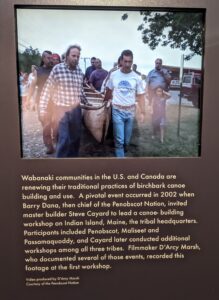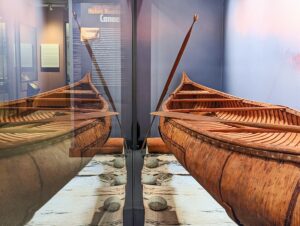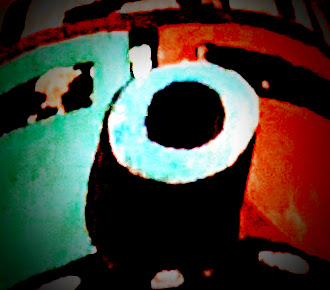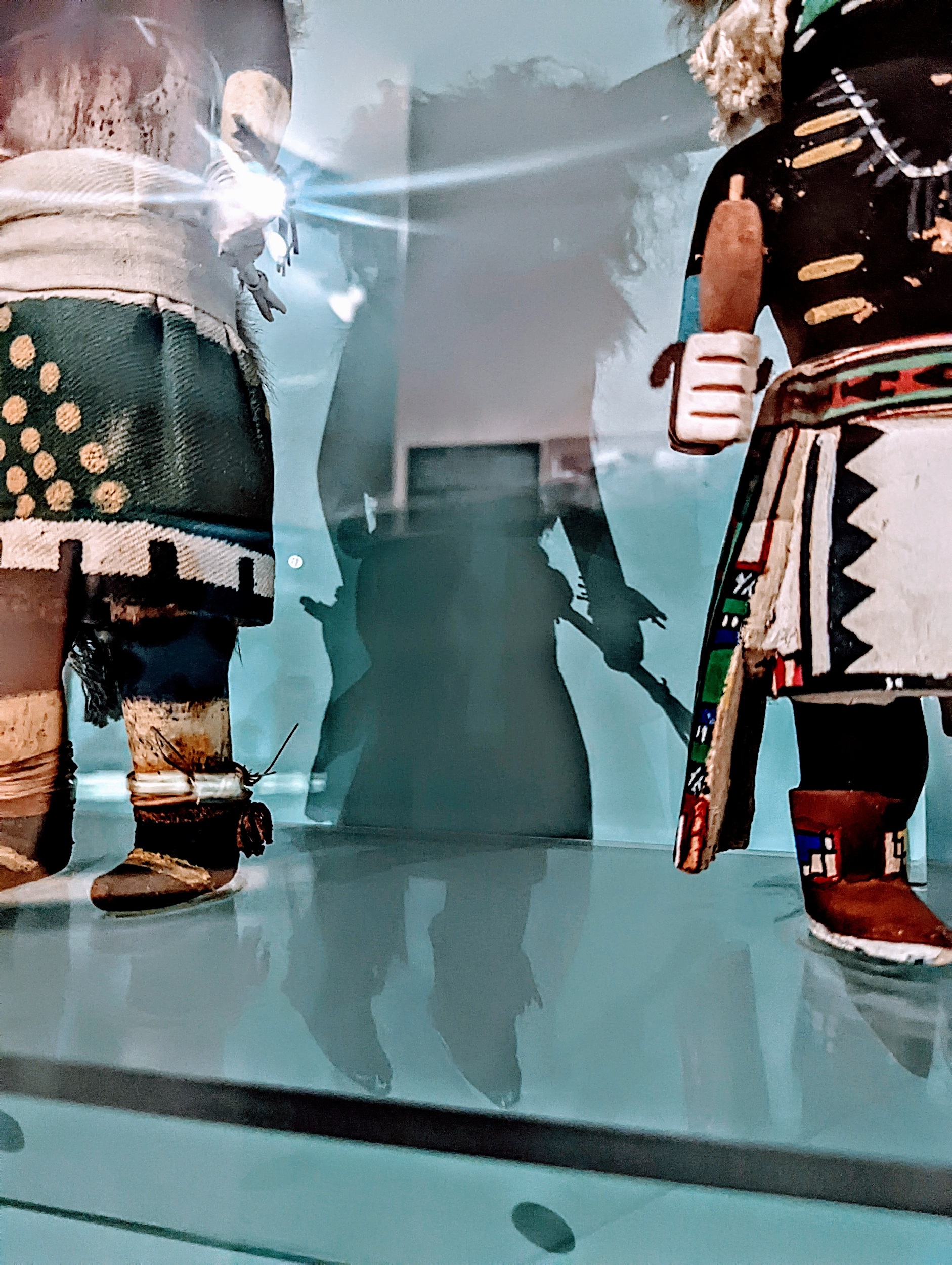Of Dreams, Relatives, Spirits and the Peabody Museum of Archaeology and Ethnology at Harvard
Author’s note: I begin by offering deep respect to each of the Indigenous communities and beings I consider in this essay, to the readers who will critically engage with this piece, and to the Massachusett Tribe at Ponkapoag who know Cambridge and Boston as their homelands. It is important to note that I write out of my own experience and do not represent the perspectives of the Native nations or the individuals whose works I consider here, including my own tribe of Ohkay Owingeh Pueblo. For the sake of style, I do not always preface my claims with phrases like, “in my view” or “it seems to me that,” but the essay should be read with these qualifications in mind. I am very grateful to generous colleagues who have offered feedback on drafts of this piece, to the conscientious Panorama editorial teams (guest and host), and to the responsive Harvard Peabody museum staff who assisted me in assembling the images. I also recognize that writing about spirited Indigenous worlds can be a precarious undertaking with more pitfalls than passages (see the first footnote on presenting my dream in this mode). I take responsibility for any errors of representation or judgment in what I have chosen to present here and how I have gone about doing so. Bearing these things in mind, I offer this essay with awe and gratitude for the Indigenous communities artists whose creativity and critiques have inspired these thoughts and who daily confound narratives of absence with vivid and tenacious presence.
A Rainbow Stretching Over the Earth, February 2019
The dream comes during that in-between period when the light is just beginning to make the world discernable. Outside it is snowy and cold, but in the dream it is summer. I look out and see a rainbow set against a dark-blue background. I look more closely, and I realize the arc isn’t in the sky but is painted on the earth. I am looking down at it from above.1
The Warp of the Harvard Peabody Museum, November 2019
Ethnographic museums, for all their pretense to unbreachable solidity, are nevertheless surprisingly holey places. The churning reservoirs of Indigenous life they seek to constrain are always bursting their bounds (fig. 1).
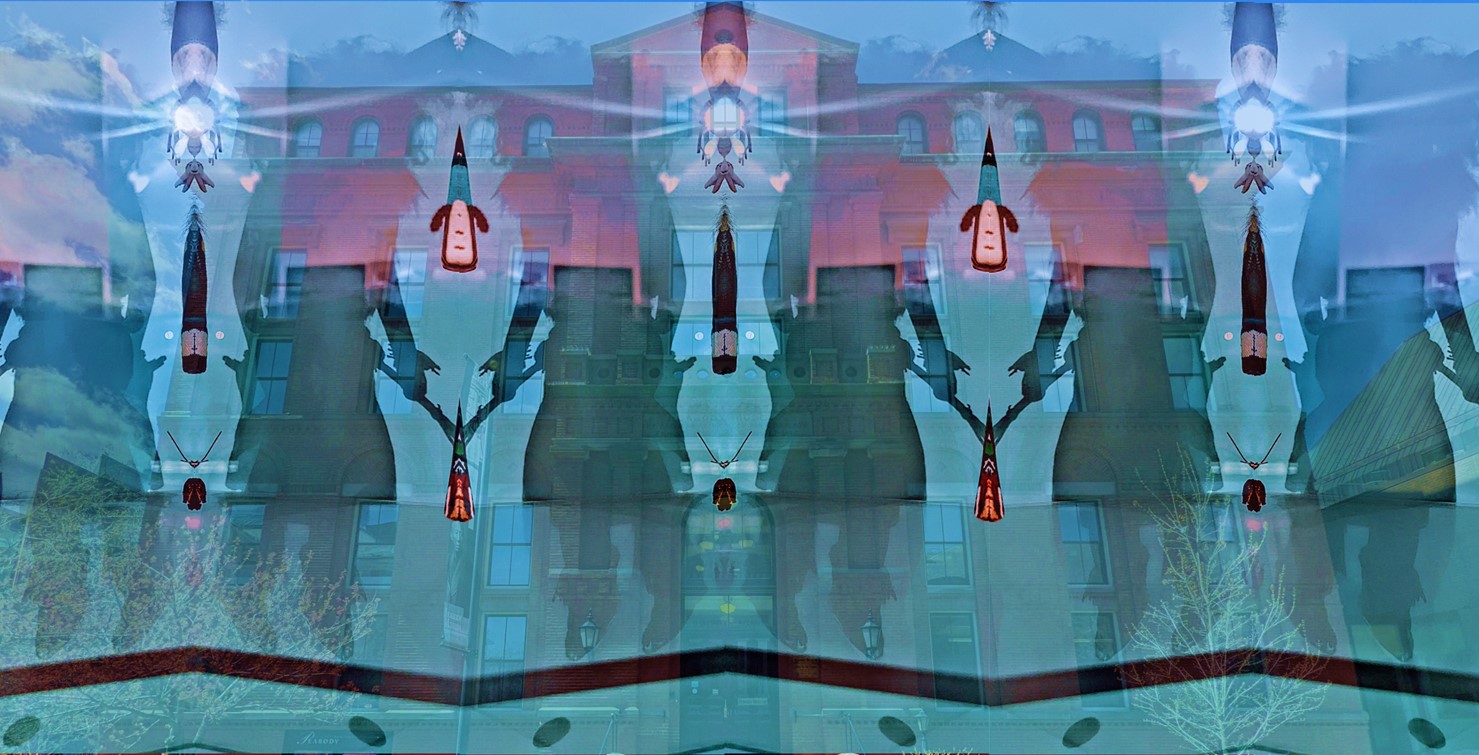
I was on a visit to Harvard University when I unexpectedly ran into a crowd of my Pueblo relatives at the Peabody Museum of Archaeology and Ethnology. It was a chilly Thursday afternoon, and I had ventured into the Hall of the North American Indian—an ambivalent space for a Native person to enter; you never know what unscrupulous acquisition or disturbing display might await in such a place. A friend had recommended a couple of the more recent exhibitions, including one on Lakota “ledger art” and a section on the Harvard Indian College archeological digs; both sounded promising.2 How was Harvard grappling with its charter to be a place of education for “English and Indian Youth of the Country,” I wondered?3 With my sensors raised, I approached the reception desk and proceeded into a time, place—and spirit—warp.
I descend and, when my feet touch the ground, I am in the middle of the pueblo. Hundreds of dancers are arranged in lines from one end of the plaza to the other. At the far end of the line, the dancers, wearing an array of regalia, curve in a bow around to the plaza on the other side.
The West
I walk into the gallery space and am greeted with the sound of an Indigenous voice coming from above, followed by the sounds of a thunderstorm. It is refreshing to hear summer sounds and an Indigenous voice in the middle of Cambridge. In the Northeast, where cities and communities pride themselves on their colonial past, Indigenous people are all too easily relegated, either temporally, to distant history, or spatially, “out West.” But Indigenous speech is always surging against the westward colonial reach. And “Indian Country”—or more specifically for the Boston area, Massachusett homelands—though less visible to many, are nevertheless ubiquitous even in what appear to be colonial hubs, like Cambridge. I take a couple deep breaths and listen to the looping track with sounds of thunder, rain, and Lak̇ot̄a language blending together in the strange gathering space of the Northeastern museum.
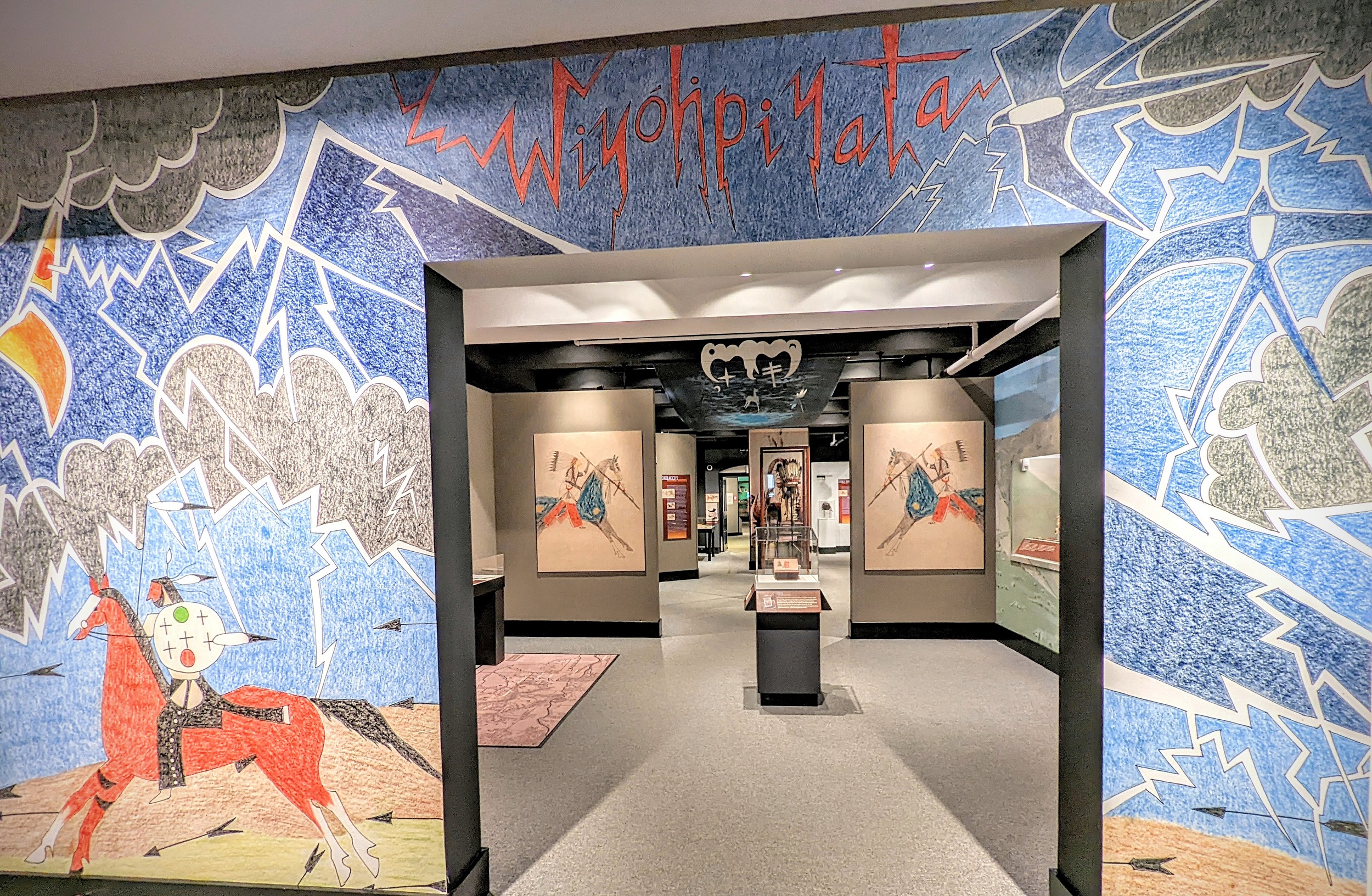
Wiyohpiyata: Lakota Images of the Contested West is an exhibition constructed around a wowapi oowa okicize owicoran (that is, a sketchbook of things done in war in Lak̇ot̄a, now commonly known as a book of “ledger art”).4 The sketchbook was found at the Battle of Greasy Grass (aka the Battle of Little Bighorn), where Lak̇ot̄a warriors resoundingly defeated General George Armstrong Custer and the Seventh Cavalry on a June morning in 1876. To enter the exhibition, I first pass through an imposing sketchbook-inspired composition that depicts dark roiling clouds, birds in flight, and lightning bolts shooting through an azure sky toward the door frame, above which is written, in crimson lightning letters, the word “Wiyohpiyata” (fig. 2). The threshold composition is the work of cocurator Butch Thunder Hawk (Hunkpapa Lakota). According to Thunder Hawk, Wiyohpiyata, the West, “is one of our four sacred directions that are associated with a color and animals. Wiyohpiyata (black/blue) is home to the spirit of thunder and lightning, Wakinyan, the Winged-One or Thunder Bird. It controls the winds, the storms and warfare.”5 In Thunder Hawk’s composition, Wiyohpiyata is a densely populated and dynamically spirited space.
There are deer dancers with racks of antlers on their heads; eagle dancers with wings extended and yellow eyes gazing from side to side; buffalo dancers with heavy heads of brown shaggy hair; butterfly dancers with long feathers extending from their foreheads; turtle dancers with evergreens and turtle shells tied to their arms and legs. The women are dressed in white and black with sashes in a broad spectrum of colors: green, red, purple, turquoise, blue, yellow. Some wear feathers in their hair; some wear elaborate headpieces. Their faces are painted with earth colors and geometric designs.
Just beyond Thunder Hawk’s stormy precipice and immediately behind a facsimile of the sketchbook are two formidable orange-trousered warriors with headdresses flying and spears extended; both are mounted on indigo-painted horses. The ready-to-strike warriors are enlarged reproductions of figures from the sketchbook rendered in colored pencil, and they form a second entryway. Standing amid two warriors, a visitor might sense a smidgeon of the awesome dread Custer likely felt as Lakota warriors charged toward him from all sides (fig. 3). We should feel disconcerted and out of place here.6 If the sketchbook of things done in war is a testament to Indigenous power, creativity, and presence, it is also a vivid indictment of settler avarice and intrusion. However natural and innocuous the ease of free museum entry might make our presence seem, we are extraterrestrials trespassing into unalienated Indigenous homelands.

Regardless of what earlier settlers saw, there has never been anything vacant about the coasts or the Plains. In the ledger drawings, clarity of vision and lucid determination, Plains and paper, meet in the perilous points of spears and pencils. Indigenous hands channel the color-saturated field of vision that reveal the Plains to be a hyperreal site of cosmological confrontation. This was the case during the Battle of Greasy Grass and continues to be so in the present day as the #NoDAPL protests have shown. The Thunderbeings are everywhere—and they are agitated (fig. 4).
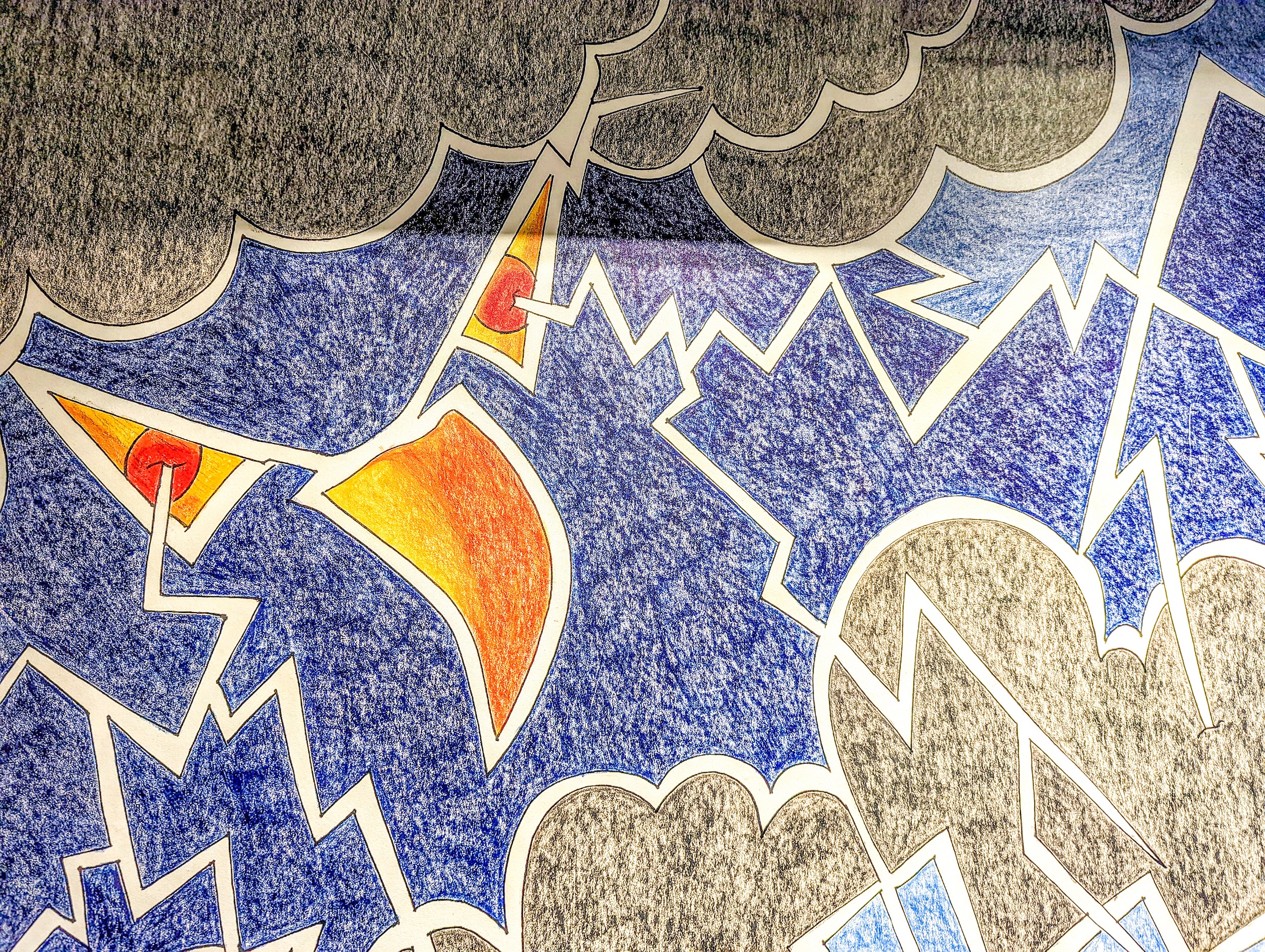
The kachinas—the Pueblo spirits—are dancing as well. Their faces are painted with earth colors and geometric designs. Deep blue, turquoise, ochre, white, checkered, orange, striped, green, black, yellow, tan, crimson. Some have tall boxy heads and thin square eyes. Some have round heads, round ears, round eyes—the mudheads. There are eagle kachinas, wolf kachinas, corn kachinas. Everyone is dancing in rhythm to the singers and drums. Bells and rattles shake. As they dance, they lift and wave the prayer bundles in their hands: corn bundles, lightning sticks, evergreens, rattles, rainbow arches.
The Northeast
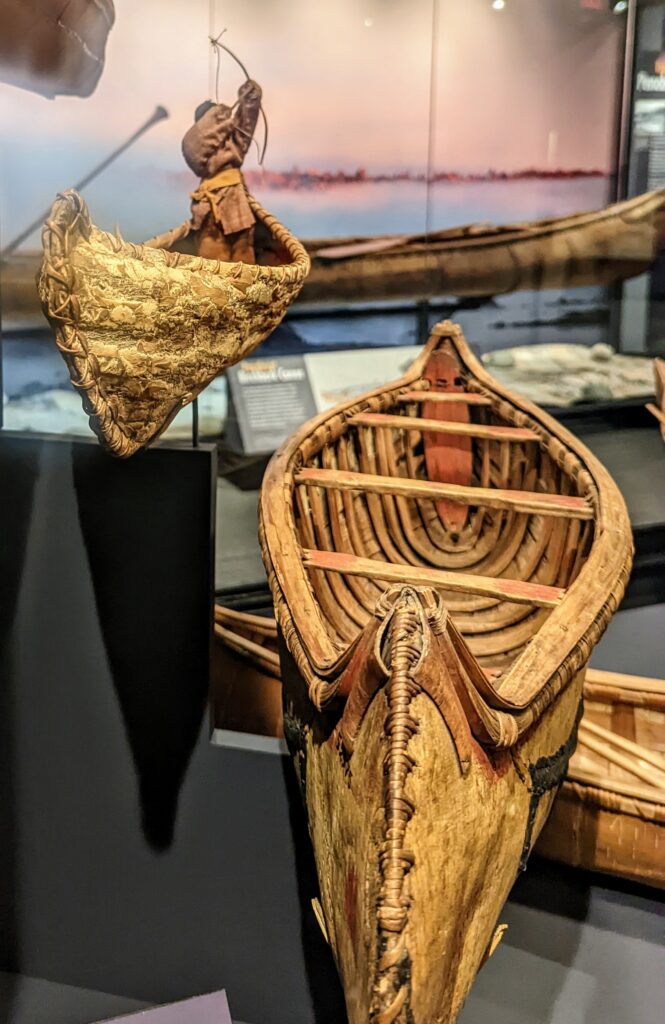
Exiting the Wiyohpiyata exhibition, I enter the Legacy of Penobscot Canoes gallery. I examine the details of the miniature canoes on display in an ambivalent two-sided case. From a standing, posterior perspective, the miniature canoes could seem to diminish as they float away into the Hall of the North American Indian on the stream of a vanishing Indian romance. But approaching the case from the front, I bring my face as close as I can, fogging the glass. From this angle, the enlarged birchbark canoes surge out of the mist and impress their presentness upon my whole field of vision (fig. 5). Other impressions flow from this.
As I move through the gallery, I watch videos of members of the Penobscot Nation fashioning a river-going vessel from the fabric of the forest with the help of a non-Native craftsperson. In its movements the finished canoe will show the porousness of numerous borders. A canoe in motion is flora and fauna, terrestrial and aquatic, craft and art, history and futurity, local and transnational. Indeed, it is safe to say that, both spatially and temporally, it exceeds the State of Maine and the borders of the United States. The people begin the process of constructing this border-crossing creature by identifying a tall birch tree in the forest with thick, sturdy bark. Then they go to work, peeling away years of its life.
I rise again to a great height. As I ascend, I see the rainbow arrangement of dancers expand, radiating eastward across the earth like rays sent out from the sun.
Soon the dancers reach the eastern coast, but they don’t stop; they continue their dance across the surface of the ocean, their feet skimming and stirring up the water.
After witnessing all the bending, molding, carving, sealing, and securing, I unexpectedly choke up as several generations of Penobscot people pick up the finished canoe and carry it down to the water during the launch ceremony (fig. 6). From a posterior perspective, the solemn procession of people carrying an oblong vessel could evoke a funeral procession, but a canoe launch is exactly the opposite: it is a procession of Indigenous life. In this ceremony, Indian men energetically carry to the water’s edge a vessel that will convey Indigenous lives up and down the river. And not only people, but knowledge, language, memory, and connection. The launch ceremony shows the continuance of Indigenous life through a tradition of craftsmanship that connects the Penobscot Nation with their forests, waterways, ancestors, neighbors, and with one another. The Penobscot canoe is every bit as vital to Indigenous thriving in the Northeast as horses are for the Lakota—and just as powerful (fig. 7). Is it any surprise to learn that the Penobscot Nation was vigorously engaged in a fight to deconstruct the dams inhibiting the flow of the Penobscot River concurrent with their determination to revive birchbark canoe construction?
Though the dancers come from the desert, it is the ocean to whom their dance-prayers are directed. They are calling to the ocean, dancing on the ocean, praying for the ocean’s health. The dancers become bands of rainbow color upon the ocean’s deep-blue body.
The Southwest
Horsepower, riverpower, mudpower. In Tewa Country, in the upper Rio Grande Valley, dust is everywhere. It is as pervasive as the air; during certain times of the year, it is the air. But in July and August, when the summer monsoons arrive, the dust mixes with rain, and it turns into a rich chocolate mud, thick and malleable.
If dust is potentiality, mud is becoming. When one has grown up immersed in mud, one learns what mud means by what mud becomes. Mud becomes the spaces within which Ohkay Owingeh peoplehood takes shape: adobe dwellings, outdoor ovens, pottery, ceremonial spaces. In our dances, people exert tremendous amounts of energy to pray for the moisture that transforms the potent dust of story and history into the density of contemporary Pueblo life. It might be said that we are a nation constituted, not by paper or proclamation, but in and through the substances and energies concentrated in mud. Mud is power and prayer—materialized.7
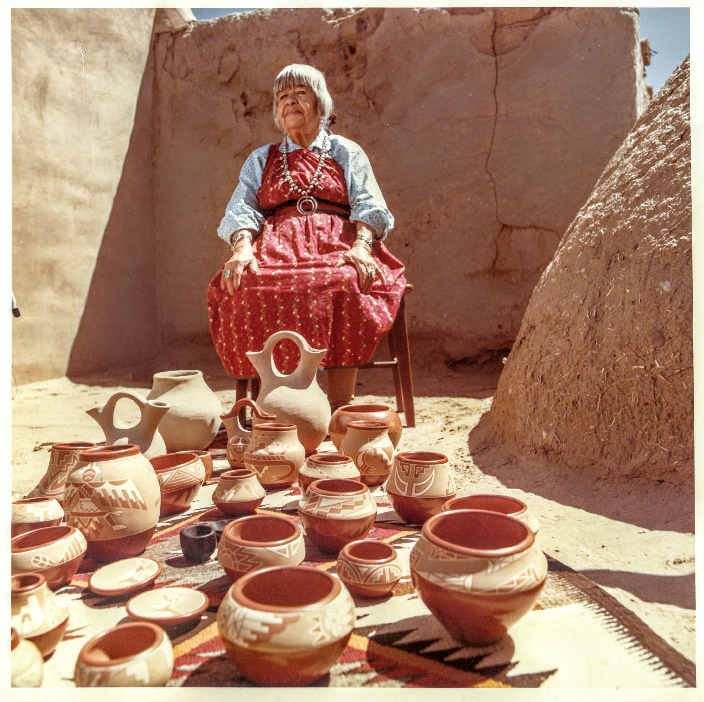
When my dad, Michael, was six years old, his connection to mud was disrupted when his parents moved to Los Angeles as part of the Voluntary Relocation Program—a work program for Indians that the federal government hoped would ease the economic strain on many Native communities and in the process, might make them into something a little less vexingly brown by becoming a little more civically and economically (if never racially) white. But Indians have an extensive history of navigating both the perils and possibilities of government programs and infrastructures. So, during the summers, my dad would take the reverse route. Shedding his concrete skin, he would glide across the desert on the too-smooth ironworks of dis/trans/relocation to visit his family in Ohkay Owingeh (then San Juan Pueblo). There, with annually increasing difficulty, he would begin the process of reconstituting his body in relation to the dust and river water of the Pueblo and the expressive valences of mudwork. Often, this entailed taking the middle seat in the cab of an old pickup truck between his dad, Manuel (who was a painter), and his grandpa Juan (who was a weaver), and they would bounce down dirt roads to the Rio Grande to gather the ingredients that his grandmother would transform into exquisite pieces of pottery.
His grandmother, Gregorita Trujillo, was a respected Ohkay Owingeh potter with hands as eloquent in the idioms of pottery as her tongue was in the Tewa language. Rolling muddy cakes into smooth snakes of clay, and then winding those into curvaceous vessels, she improvised on the red-on-tan pottery style of the pueblo with a lucid eye toward the tourist and collector markets in Santa Fe (fig. 8). After his grandmother formed the pieces into bowls, platters, or vases, his father would animate the pieces with Pueblo motifs: deer dancers, eagle dancers, sun and cloud designs. One of his father’s favorite figures to paint was a kachina clown called a mudhead. He often rendered his mudheads with round heads, donut eyes, donut mouths, and two globular balls as ears. The expression of a mudhead is one of disquieting curiosity. They never blink, just stare with an unremitting “ooh,” as though they are observing all the bizarre happenings of life transpire.
I wonder what the mudheads made of the three generations of Trujillos bouncing down the muddy and cratered back roads through the cottonwood forest to the river. I imagine them sitting in the bed of the truck, planning what mischief they might get up to this time. Maybe they would toss out a shovel on the way, requiring the boy to walk back to look for it alone, as they made sounds in the willows that would send him sprinting through puddles and brush. Maybe they would direct the vehicle into a muddy patch where the two grown men would have to get out and push while the boy punched the gas, splattering the men with mud. Or maybe they would be content to sit on the top of the truck and watch as the three humans shoveled sand and clay in the summer heat, their sweating bodies becoming encrusted with a thick slip of clay dust until they were themselves transformed into mudheads working under the sun. The kachinas must have gotten a kick out of that.
It might seem mischievous, but that, perhaps, is how the dust of everyday Pueblo life is transformed into powerful, nation-making stories; how relatives are reminded of their inseverable relatedness; how people come to learn that there is always more going on in the world than can been seen. It was probably a comedown for the mudheads, when, after the shoveling was done and all the mischief accomplished, the humans took a refreshing plunge in the river, where the strong current would invigorate their mud-fortified flesh.
The Pueblo dancers’ prayers are received. The water begins to foment; clouds begin to form.
The Meeting
I exit the Penobscot exhibition and enter an older part of the Hall of the North American Indian that houses ethnographic art from the Southwest. This part of the gallery doesn’t just feel old, it feels eerie. It feels like I have crossed a threshold into another time, maybe 1968, maybe earlier? Yes. That’s exactly it. In this hall, I have yet to be born. This hall doesn’t even know I’m alive. Perhaps, it supposes that I shouldn’t be—alive—Indigenous—here.
Then I begin to weep.
I weep because I am not among the dancers whose bodies are filling the world with color and movement, whose prayers are maintaining the relationship between desert and sea.
I weep because I don’t have the language to speak or sing the prayers.
I weep because I know I will not be there when the Thunderbeings arrive from beyond the mountains bringing rain to my pueblo. I will not be there because I am two thousand miles away in the east.
I turn a corner and I don’t see anyone, but I feel like I am not alone. I’m not. I look to the side, and I see them. And I am not prepared to see them. But they are looking straight at me (fig. 9).
A rainbow of kachinas bend around me in a multitiered triptych of spirits. Their faces are painted with earth colors and geometric designs. Deep blue, turquoise, ochre, white, checkered, orange, striped, green, black, yellow, tan, crimson. Some have tall boxy heads and thin square eyes. There are eagle kachinas, wolf kachinas, corn kachinas. They lift their moccasined feet and wave the rattles and prayer bundles in their hands: corn bundles, lightning sticks, and rattles. All of them are dancing (fig. 10).
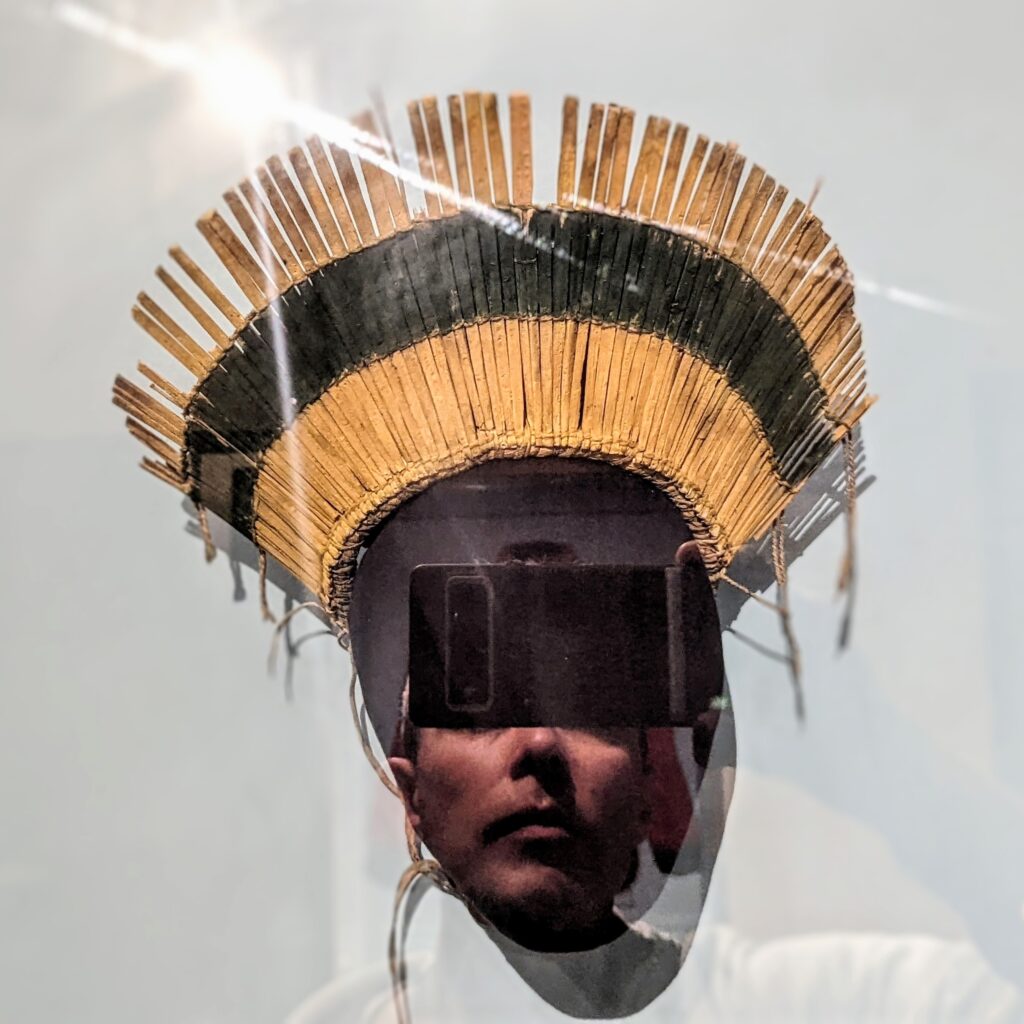
I wake up, and for a while, I feel the intense wonder and grief of the dream still burning in my eyes and in my chest. I lay in bed thinking about it for a long time, until I start to see orange sunlight begin to warm the tops of snow-covered houses and the bare tips of the trees outside.
I watch my Pueblo relatives in stunned silence. I watch them watching me. I feel my eyes widening into mudhead eyes, my mouth forming the “ooh.” How long have they been dancing in this space? How did they make the journey from the Southwest to the Northeast? What kinds of prayers and messages are they sending back to their Pueblo homes? How many of their relatives have come here to visit them? Why are they on exhibition like this? What are they doing? Why are they here?
I stand in the presence of this disquieting wall of spirits, and questions about their acquisition, confinement, and display keep coming. At the same time, it also begins to dawn on me that these are beings whose feet have been communicating with earth, clouds, and ocean since time immemorial; whose spirits traveled here long before their bodies arrived; who return every summer to the Southwest, bringing the thunderclouds. These places—the Northeast and the Southwest—have always been talking to each other. I have just walked into a space of clandestine communion, and this is a contraband shrine. Another impression flows from these, and it strikes me in my core: whether here or there, sleeping or awake, dancing or dreaming, I am part of that rainbow (fig. 11).
Reflections on the Peabody Museum at Harvard
The Peabody Museum at Harvard could not have planned for this kind of encounter. Those who amassed these works had little clue as to who it was they were purchasing or pilfering from Indigenous people and transporting in droves from the deserts, lakes, mountains, forests, rivers, islands, and tundra to the Northeast. Even in the instances when Indigenous caretakers and creators gifted or entrusted these spirited Indigenous works for safekeeping to individuals or institutions, the collectors often didn’t know how to properly relate with or accommodate them and didn’t understand the responsibilities that came along with them. They didn’t know who it was that populated their living spaces and galleries; curators had no idea who it was that was watching and scrutinizing them. In their eagerness to procure hordes of ethnographic “objects,” acquisition agents didn’t know what kind of Indigenous beings they were ingesting or the kind of mayhem those beings could stir up in their institutional bellies. That many restless bodies dancing, partying, and protesting can cause some serious gastrointestinal distress. And that is not all that is going on inside the Harvard Peabody.
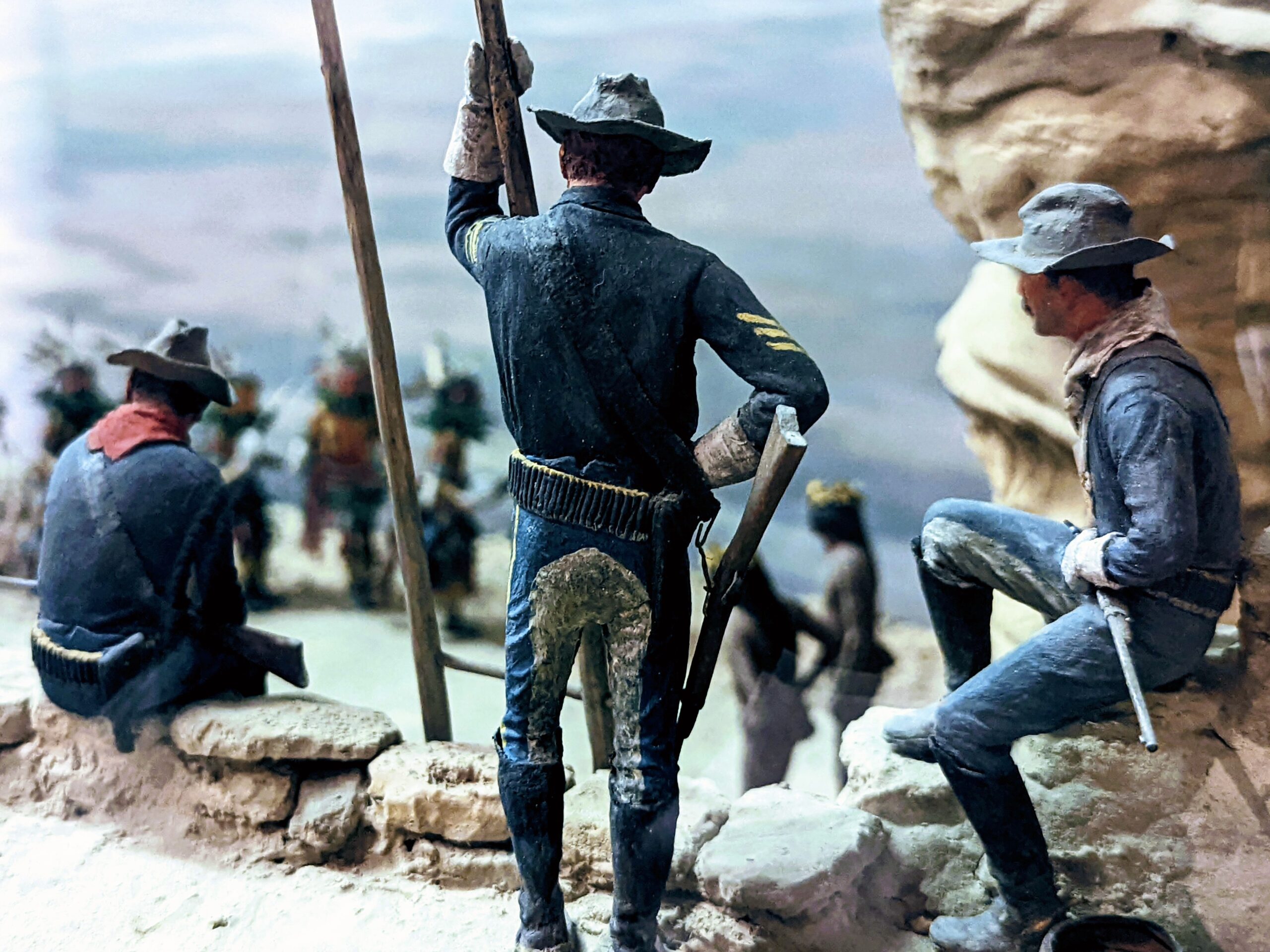
There are villages full of restless bones that scratch at their boxes and seek to carry themselves back to the earth from which they were disinterred, back to their relatives from whom they were dismembered. Indeed, the Harvard Peabody is not a museum or a repository of ethnographic materials; it is one of Harvard’s most overpopulated and unrecognized residence halls. The building is one of the most Indigenous and spiritually charged places in the whole university.
It is no secret that the Hall of the North American Indian is long overdue for a redesign—to walk through the museum is to move through decades of curatorial time. But more is needed to address the uproar taking place in the museum than a makeover of its galleries. Redesign begins with reconstitution, a process that has profound implications. We might think of those deeper shifts in terms of some of their more apparent and tangible practices. One set of practices has to do with turning from habits of acquisition to rituals of remembering. What might this look like?
For one, remembering requires cultivating a pedagogy of response-ability; that is, making known and teaching from the museum’s history and embracing the responsibilities and obligations that come with the many residents it houses. I’d suggest that the troubling diorama of an imagined Hopi kachina dance with three soldiers surveying the ceremony from above speaks quite candidly about the hungry bodies and eyes the museum privileges and the forces that have made Indigenous peoples and our culture subjects and objects of fascination and acquisition (fig. 12).
Remembering also requires enacting rituals of relinquishment; that is, practicing, over and over, the unsettling—unsettlering—movement of releasing its grip on the troves of spirited bodies it has spent over a century and a half seeking to possess. Perhaps, by developing a regular practice of relinquishment, the Peabody Museum can help cultivate this ethos in students and patrons as well. As students, the public, and the university become more nimble in performing rituals of relinquishment by repatriating museum collections to their Indigenous creators, they will also come to recognize not only the prudence but the imperative of returning other kinds of entities to Indigenous peoples: deserts, lakes, mountains, forests, rivers, islands, tundra, ice caps.
And remembering requires abandoning strategies of possession and embracing, instead, practices of relation; that is, becoming a porous place where the Indigenous communities that are too often characterized as “collections” are reunited and interact regularly with their relatives and kin—maybe at Harvard but probably much more fittingly back in their Indigenous homes. Ultimately, remembering cannot be a reductively cerebral notion but must be an expansively corporeal process in which Indigenous bodies, lands, and spirits are revitalized as they are re-membered—rejoined—with one another.
None of this is easy or straightforward. But there are some indicators that a tentative but significant shift may be slowly underway. The Wiyohpiyata exhibition, the Legacy of Penobscot Canoes gallery, and the Revitalizing Indigenous Languages kiosk offer some promising glimpses into what the Peabody museum might become with increased momentum. But the Hall of the North American Indian offers a contrary, cautionary tale about the lull of inertia that can easily settle over an institution. No doubt there are less visible efforts underway to make the museum much more responsive to Indigenous communities through repatriation, educational programing, and curatorial practice. But a handful of museum staff and advisors can hardly be expected to bear the weight of an entire institution’s expropriative history—the university cannot outsource accountability. Furthermore, neither the museum nor the university can reconstitute themselves as sites of Indigenous futurity on their own. Reconstitution must necessarily be a momentous spiritual, diplomatic, and fiscal undertaking that must be guided by Indigenous insight, critique, creativity, and, most of all, care. After all, the Peabody does not contain forgotten “collections of things” but beloved communities of beings.
Whether the museum hears it or not, there is a disruptive deep-time dialogue transpiring between the spirited beings who reside in the Peabody and their Indigenous relatives and homelands. The kachinas and their countless companions are the materialized creatures of voyaging visions and homecoming dreams. They are beings very much alive, extraordinarily articulate, and incredibly determined. They are beings who want to be respected and carefully re-membered.
We Are Here
It is nighttime, and I am still full of astonishment. When I get to my computer, I pull up the Harvard Peabody website and open the search page for their online collection. I have to see if she is there.
There is one entry for “Incised ceramic plate: deer dancer motif,” with the object description:
Red-on-buff incised plate with polished redware exterior and interior with buff background and full figure white deer dancer in profile outlined in red with red decoration. Dimensions: 2.7 cm high x 18.4 cm max. dia.* Signed on bottom, Gregorita Trujillo San Juan Pueblo NM.8
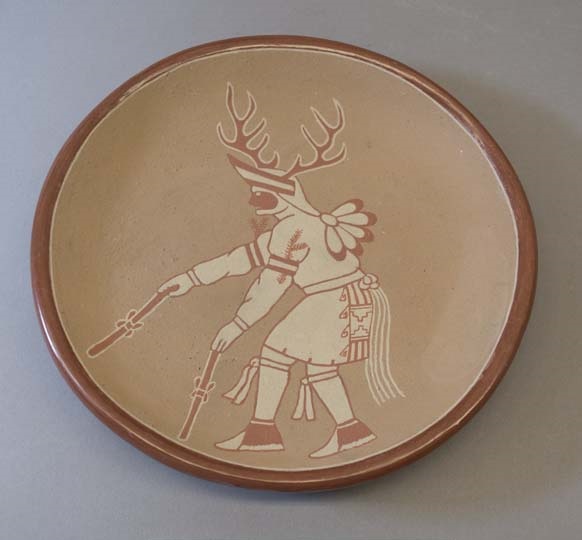
This is my great grandmother’s pottery, and the deer dancer is my grandfather’s illustration (fig. 13). Perhaps my dad helped gather and prepare the clay. According to the entry, my family has been in residence at Harvard for twenty-five years.
When I lay down and close my eyes to sleep, I see all the dancers in my dream as they move in a rainbow formation toward the ocean; I see the kachinas enveloping me in the Peabody; I see the deer dancer striding across my great grandmother’s pottery. And I think: They are here.
We are here.
Cite this article: Anthony Trujillo, “Of Dreams, Relatives, Spirits and the Peabody Museum of Archaeology and Ethnology at Harvard,” in “Art History and the Local,” In the Round, Panorama: Journal of the Association of Historians of American Art 8, no. 1 (Spring 2022), https://doi.org/10.24926/24716839.13183.
PDF: Trujillo, Of Dreams, Relatives, Spirits
Notes
- The dream segments in this essay are indicated with italics. I have felt strongly in two directions (ambi-valent) about whether to relate the dream that came to me months before visiting the Peabody. There is a strong argument to be made that creative nonfiction may not be the best way to relate a dream such as this, and an open-access journal of art history may not be the most fitting venue in which a dream may dance. Indeed, I contemplated removing the dream components of this essay altogether. But, to use a pottery analogy, that felt like I would be presenting a pot without a design. Better to refrain from publishing the essay altogether (another option) than to separate the animating spirit-dream of the piece from its narrative body. It seems to me that this conundrum has a close analogue in the creation of Indigenous arts for the market or for public presentation, especially when Indigenous artists use designs they know hold deep cosmological significance. In this essay, the threshold composition by Butch Thunder Hawk and my great grandmother Gregorita’s pottery pieces are examples of this. What these artworks signal to me is that there are multiple layers of meaning and affect in every design, which open up into conversations of varying levels of intimacy between Indigenous artists and their interlocutors, depending on the degree to which both can attune to an underlying music. As it concerns relating my dream in this form and forum, I know how profoundly the dream has danced within me and that I have related only a thin band of its brilliance and color. This is the case partly because there are aspects of the dream I have chosen to withhold, partly because there are intensities of meaning that I am still learning to perceive, and partly because there are many aspects of this dream that cannot be articulated in writing but only through alterNative media in alterNative contexts. I hope that what I have shared is sufficient to convey an argument that will strike a chord with some readers. ↵
- I discuss the term “ledger art” later in the essay and in note 7 below. ↵
- The history of the Harvard University Native American Program (HUNAP) shows the link between the university’s original charter and the continuing Native presence and programming today. See Peabody Museum of Archaeology and Ethnology, “Wiyohpiyata: Lakota Images of the Contested West,” exhibition brochure (Cambridge, MA: Harvard University, 2009), https://hwpi.harvard.edu/files/peabody/files/wiyohpiyata_brochure.pdf?m=1627332476; and “Mission,” Harvard University Native American Program, accessed May 23, 2022, https://hunap.harvard.edu/mission. ↵
- This Lakota way of describing the drawings is noted on one of the labels below the sketchbook. Another label notes that “the ledger book of drawings was found in a funerary tipi after the Little Bighorn Battle and is subject to the Native American Graves Protection and Repatriation Act. Now in Houghton Library MS. Am 2337, the book is the subject of ongoing consultation and research by Houghton Library, the Peabody Museum, and the Standing Rock Sioux Tribe.” The Wiyohpiyata exhibition opened in 2009. As of my most recent visit to the museum in May 2022, there is no update online or in the museum as to what has happened since. While it is possible that the sketchbook of things done in war has been repatriated, visitors must still speculate about its current status. ↵
- “Wiyopihyata: Lakota Images of the Contested West.” ↵
- By accepting too quickly the shorthand description of these works as “ledger art” as a way of making these works legible, scholars and critics can enact a subtle settler reversal of a potent Indigenous tradition. The term “ledger art” can situate Indigenous people and expressive forms between two pointed colonial discourses: the literary/market discourses of the ledger and the and the aesthetic discourses of “art.” On the contrary, by visually depicting “things done in war” whether on hides or on paper, Lakota artists and other Indigenous nations that practice this tradition position settlers, settler discourses and materials spatially, within Indigenous terrain, and conceptually, within their graphic discourses of power and sovereignty. When reaching for shorthand terms like “art,” it is important to be mindful that Indigenous expressive forms should expand and disrupt these concepts rather than being reduced and constricted by them. ↵
- It should be noted that my observations in this section are an exercise in what I consider Pueblo poetics in literary form, not altogether unlike the material creations of Pueblo artists. These observations emerge from the mud of my own lived experience and imagination and should not be misidentified as being expressions of Tewa cosmology or ceremonial knowledge. These ruminations may be resonant for some Pueblo people and discordant for others. ↵
- Peabody Museum of Archaeology and Ethnology, Harvard University, Cambridge, MA; bequest of William R. Wright, 1995; 995-29-10/73582. ↵
About the Author(s): Anthony Trujillo (Ohkay Owingeh Pueblo) is a PhD candidate in American Studies at Harvard University.


